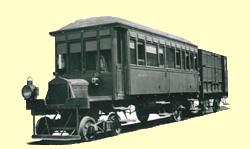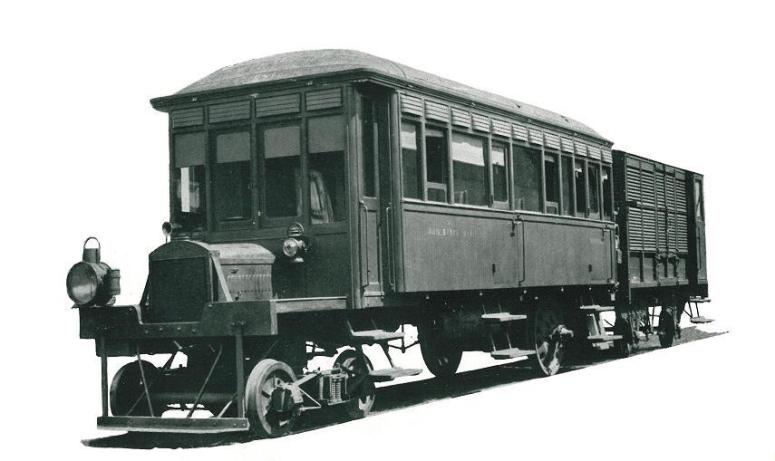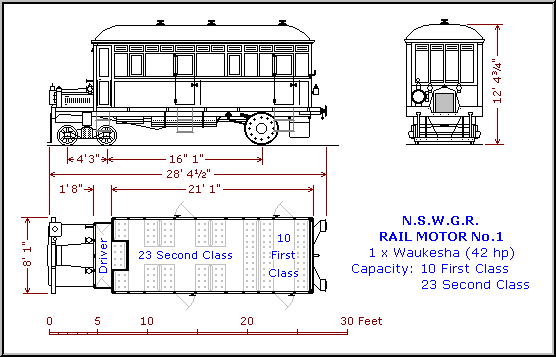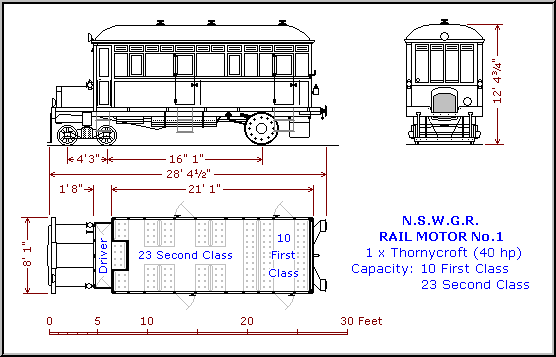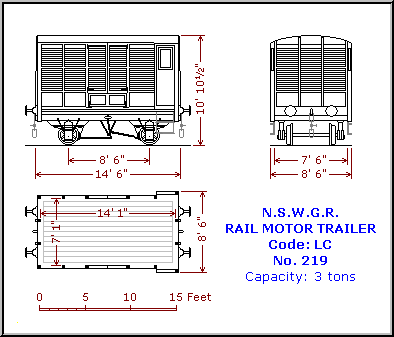|
|||||||||
INTRODUCTION
The wooden body was similar in style to the end platform suburban cars used in Sydney and was finished in narrow tongue and groove boards. It was divided into three separate sections, accommodating 33 passengers and 2 crew. The first section was the cab, which accommodated the train crew (the driver and the guard). The second section (the forward compartment) accommodated 23 passengers and the third section (the rear compartment) was a smoking area and accommodated 10 passengers. The two passenger compartments were fitted with transverse seats and drop type windows, and each compartment had two doors, which opened outwards. There was no interconnection between the three compartments. Steps were fitted under each of the doors to allow passengers to alight from the vehicle to ground level. To allow the vehicle to run on rails, the road wheels were removed and suitable railway wheels were fitted. A four-wheel bogie replaced the leading wheels while the rear driving wheels were changed to railway contour wheels.
The vehicle was powered by a 42 hp 4-cylinder Waukesha petrol engine. This engine weighed approximately ½ ton and the vehicle was geared for road speed of 30 mph. The original Waukesha engine was replaced with a 4-cylinder 40 hp Thornycroft petrol unit in 1923. The engine was fitted to the leading or driving end of the vehicle and the original truck radiator and cowling were retained. A small cowcatcher and an acetylene headlight were mounted on the headstock. The Rail Motor was designed to run in one direction only and draw-gear was fitted to the trailing end so that a trailer could be attached for hauling light goods and parcels. A collapsible tricycle (trike) was also carried for the train crew’s use in case of an emergency or breakdown in the section. This was carried on the back of the Rail Motor. The experimental vehicle attained a speed of 25 mph on its trial run to Waterfall on the 19th September 1919. After successful trials the vehicle was adorned with the name RAIL MOTOR No.1 and entered revenue service on the then isolated Lismore to Grafton section on the 1st October 1919. In November 1925, after six years of reliable service, Rail Motor No.1 was withdrawn from passenger traffic and it took on a new role as the Signal Engineer's inspection car. It subsequently lost its title of Rail Motor No.1 as this was re-allocated to one the newly designed 42-foot Rail Motors in November 1926. No.1 was finally withdrawn from railway service in 1930. The body was sold and it began a new life as a house in the Coffs Harbour region, while the chassis was scrapped. TRAILER LC 219Rail Motor No.1 was operating very successfully over the Grafton to Lismore line and this section was experiencing an increase in goods traffic, mainly cream. The prototype rail motor was designed for passengers only, so to capitalise on the benefits of this experimental vehicle, a companion trailer was designed and built in Eveleigh workshops. The trailer entered service in 1920. This vehicle was a four-wheel trailer of a wooden frame construction and was capable of carrying 72 cans of cream or 3 tons of goods and had a separate Guard’s compartment. This vehicle was coded LC 219. Goods were loaded through double doors provided in the centre of the vehicle. Access to the Guard's compartment was through a small door located on each side at one end. The guard's compartment was fitted with glazed lookouts. Each end of the trailer was fitted with small buffers and adjustable screw drawgear. A handbrake, acting on all wheels, was operated from the guard's compartment. Trailer LC 219 was withdrawn from service in November 1925, at the same time as Rail Motor No.1. On withdrawal, the vehicle was transferred to The Rock for use as a fitter's repair van where the body was removed from the underframe. VEHICLE CONFIGURATIONS
REFERENCES
|
|||||||||
